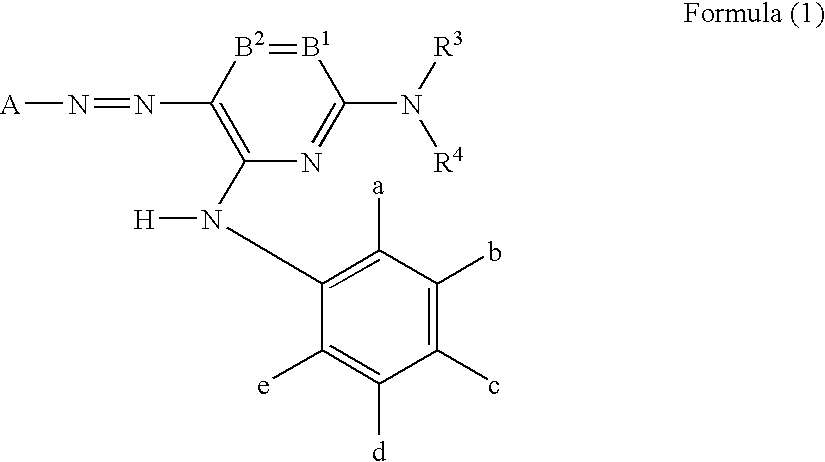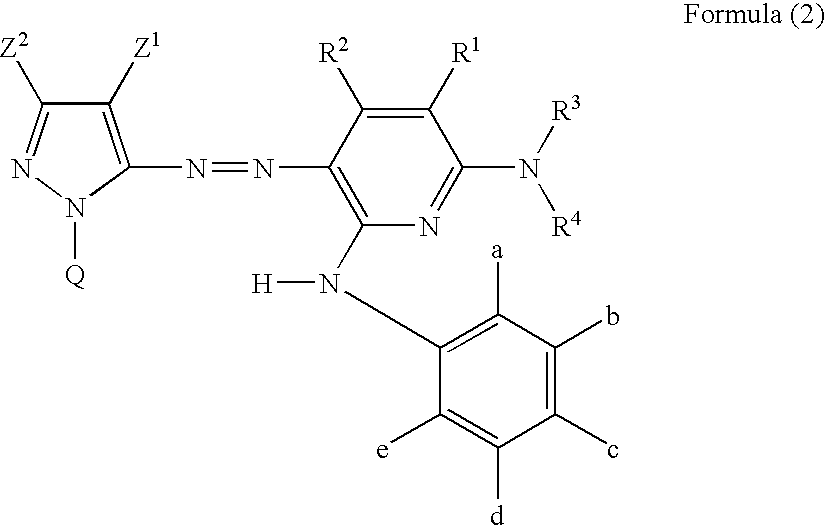Ink for ink-jet recording, ink set, and ink-jet recording method
- Summary
- Abstract
- Description
- Claims
- Application Information
AI Technical Summary
Benefits of technology
Problems solved by technology
Method used
Image
Examples
example 1
[0309] 150 cc of ultrapure water (specific resistance value: 18 MΩ or higher) was added to 17.5 g of a magenta dye (M−1), and the dye was dissolved under stirring for 10 minutes while applying sound wave vibration using a ultrasonic washing machine (2510J-DTH Model, a product of BRANSON, 42 kHz, 125W). The following components were added to the dye solution, and deionized water added to make 1 liter. The resulting solution was mixed under stirring for 1 hour while heating at 30 to 40° C. The solution was filtered with a microfilter having an average pore diameter of 0.25 μm under reduced pressure to prepare an ink liquid for light magenta (LM-101).
Glycerin (GR) 102 g / lTriethylene glycol (TEG) 19 g / lTriethylene glycol monobutyl ether (TGB) 104 g / l1,2-Hexanediol 12 g / l2-Pyrrolidone 11 g / lTriethanolamine (TEA) 2.0 g / lBenzotriazole0.08 g / l1,2-benzoisothiazolin-3-one (PROXEL XL2) 1.0 g / l
[0310] 500 cc of ultrapure water (specific resistance value: 18 NM or higher) was added to 68.0 g...
example 2
[0328] The same ink set prepared in Example 1 was charged in a cartridge of a ink-jet printer Pixus 8600i (a product of Canon Co.), and an image was printed on an ink-jet paper “Gasai”, photograph finish, a product of Fuji Photo Film Co., using the printer. The evaluation as in Example 1 was made. As a result, the same result as in Example 1 was obtained. Further, even when the image receiving paper was a photographic paper, a product of Seiko Epson Corporation, PR101, a product of Canon Co., and a photo paper (premium plus (glossy)), a product of Hewlett-Packard, the same effect was obtained.
example 3
(Preparation of Each Ink Composition)
[0329] Each component was mixed based on the formulation shown in Tables 6, 7 and 8 below, and stirred at room temperature for 30 minutes. The solution obtained was filtered using a membrane filter having an opening of 1.0 μm to obtain each ink composition. In Tables 6, 7 and 8, the numerical value in each component shows mass % of each component when the mass of an ink composition is 100%. The term “remainder” showing the amount of water shows the amount that the sum of water and components other than water is 100%.
TABLE 6Y-1Y-2Y-3Y-4Y-5C-1C-2C-3C-4C-5YELLOW-15YELLOW-25YELLOW-35YELLOW-41YELLOW-51.5YELLOW-61.5YELLOW-70.5CYAN-154.54CYAN-20.51CYAN-3CYAN-45CYAN-55Glycerin12121212121212121212Triethylene glycol10101010101111111111Propylene glycol352TEGmBE1010107599999Surfinol 465 (*1)1111111111Urea22222222221,2-Hexanediol23322222,5-dimethyl-2,5-22hexanediolTriethanolanime0.10.10.10.10.10.10.10.10.10.12-Pyrrolidone44444PROXEL0.30.30.30.30.30.30.30....
PUM
| Property | Measurement | Unit |
|---|---|---|
| Density | aaaaa | aaaaa |
| Pressure | aaaaa | aaaaa |
| Pressure | aaaaa | aaaaa |
Abstract
Description
Claims
Application Information
 Login to View More
Login to View More - Generate Ideas
- Intellectual Property
- Life Sciences
- Materials
- Tech Scout
- Unparalleled Data Quality
- Higher Quality Content
- 60% Fewer Hallucinations
Browse by: Latest US Patents, China's latest patents, Technical Efficacy Thesaurus, Application Domain, Technology Topic, Popular Technical Reports.
© 2025 PatSnap. All rights reserved.Legal|Privacy policy|Modern Slavery Act Transparency Statement|Sitemap|About US| Contact US: help@patsnap.com



